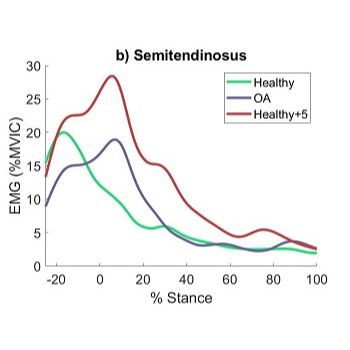Postural Control and Knee Muscle Activation
People with knee osteoarthritis are known to overactivate the muscles around their knees. This overactivation (or excessive muscle tension) will increase the mechanical load on the joint and has been linked to an increased rate of cartilage loss and poor long-term clinical outcomes. It is therefore important to understand what is driving this muscle overactivity.
We are exploring the degree to which altered muscle activation of the knee muscles in walking is a direct consequence of suboptimal postural control of the upper body. The idea is that subtle changes in the position/orientation of the trunk will force the muscles around the hip and knee to work harder to maintain postural control, changing normal phasic activation patterns.
We have explored this idea by using a biofeedback approach to instruct healthy people to walk with a very small (5 degree) increase in forward lean. When we do this, the activation pattern of the medial hamstring (semitendinosus) muscle changes dramatically and becomes similar to the pattern observed in people with knee osteoarthritis (OA), as shown in the figure below. This is important because people with knee OA do walk with an increase in forward lean. This work has been published and we are currently exploring the potential impact of other subtle changes in postural control.

The project is being led by Prof Steve Preece